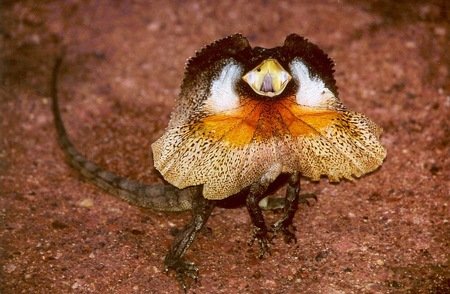
Let’s dive into some of the most common misconceptions about frilled lizards. This will help clear up any confusion and give you a better understanding of these cool creatures. Whether you’re a budding reptile enthusiast or just curious about nature, unpacking these myths will hopefully shed some light on this impressive lizard.
Myth
You might picture a frilled lizard as an angry creature ready to attack at any moment. Here’s the thing: while they can display aggressive behavior when threatened, they’re not constantly on the hunt for trouble. Most of the time, a frilled lizard would rather avoid confrontation altogether.
When feeling threatened, a frilled lizard will raise its frill, open its mouth wide, and puff itself up to appear larger. This display is more about intimidation than actual aggression. They’re hoping that the show will convince predators to back off. Honestly, if you think of them as a small dog barking loudly to scare away a stranger, you get the right idea. They’d prefer to simply retreat to the safety of a tree than engage in a fight.
Myth
It’s easy to see why some might think frilled lizards can fly. Their ability to glide from tree to tree is impressive! However, they don’t actually fly in the bird sense. Instead, they use their flaps of skin and limbs to glide short distances.
Think of it like a kid jumping off a slide, arms out, hoping to soar for just a moment before landing. Frilled lizards can leap from high branches and spread their frills out to catch the wind, helping them glide for several meters. But they’re no feathered aviators, and their “flying” skills are more about maneuvering than actual flight.
Myth
While the Chlamydosaurus kingii is the most well-known frilled lizard, not all frilled lizards are created equal. There are different species, each with their unique traits and habitats. For instance, some frilled lizards come in various colors and patterns, which help them blend into their surroundings.
You might find them in different settings across Australia and New Guinea. Each species has adapted to its environment in interesting ways. So, while you might think of a frilled lizard as just one type, it’s really a diverse group of fascinating reptiles. Each one brings something a little unique to the table!
Myth
It’s a common belief that frilled lizards are strict insectivores, but that’s not entirely true. While they enjoy munching on insects like crickets and grasshoppers, they also have a varied diet. In the wild, they consume leaves, fruits, and flowers as well.
Think of them as the ultimate buffet diners—always looking for a little variety! This flexibility in their diet helps them thrive in the wild, especially during droughts or other environmental changes when their usual insect prey might be harder to find.
Myth
It’s natural to think that with such a cool look, frilled lizards would make great pets. But here’s the rub: they are not the easiest reptiles to care for. They require specific temperature and humidity levels to stay healthy, making their care quite a commitment.
If you’re considering a frilled lizard as a pet, it’s crucial to do your homework. They thrive in environments that mimic their wild habitats, which can be tricky to recreate in your home. Many people underestimate the effort needed to keep them healthy. So while they might look fantastic in a habitat, they can be challenging to keep alive and happy.
Myth
While it may seem like frilled lizards spend most of their time on the ground, they are quite arboreal—meaning they prefer life in the trees! They’re excellent climbers, often seen basking on branches or hides among leaves.
Being up high provides them with safety from ground predators and a vantage point to look for food. Imagine climbing a tree to escape a hungry dog; that’s just what these lizards do to avoid danger!
Myth
You might hear people say that frilled lizards are endangered, but that’s not quite the case. While their habitats are threatened by human activity, frilled lizards are not currently classified as endangered. They have stable populations in many areas.
That said, habitat destruction is a real concern. As forests are cleared for agriculture and urban development, the challenges for these lizards can grow. The conversation about protecting their environment is crucial, even if the lizards themselves are not on the brink of extinction.
Frilled lizards are fascinating creatures that often get misrepresented in media and conversation. By unpacking these myths and misconceptions, you can deepen your understanding of these incredible reptiles. They might not be the dangerous monsters they’re often made out to be, nor the perfect pet you’re dreaming of.
Next time you come across a frilled lizard—whether online or in the wild—remember what you’ve learned. They’re unique creatures with their own needs and behaviors. Recognizing the truth behind these myths can help foster a respect for frilled lizards and their habitats. So, let’s appreciate them for what they are and spread the word about their realities!
